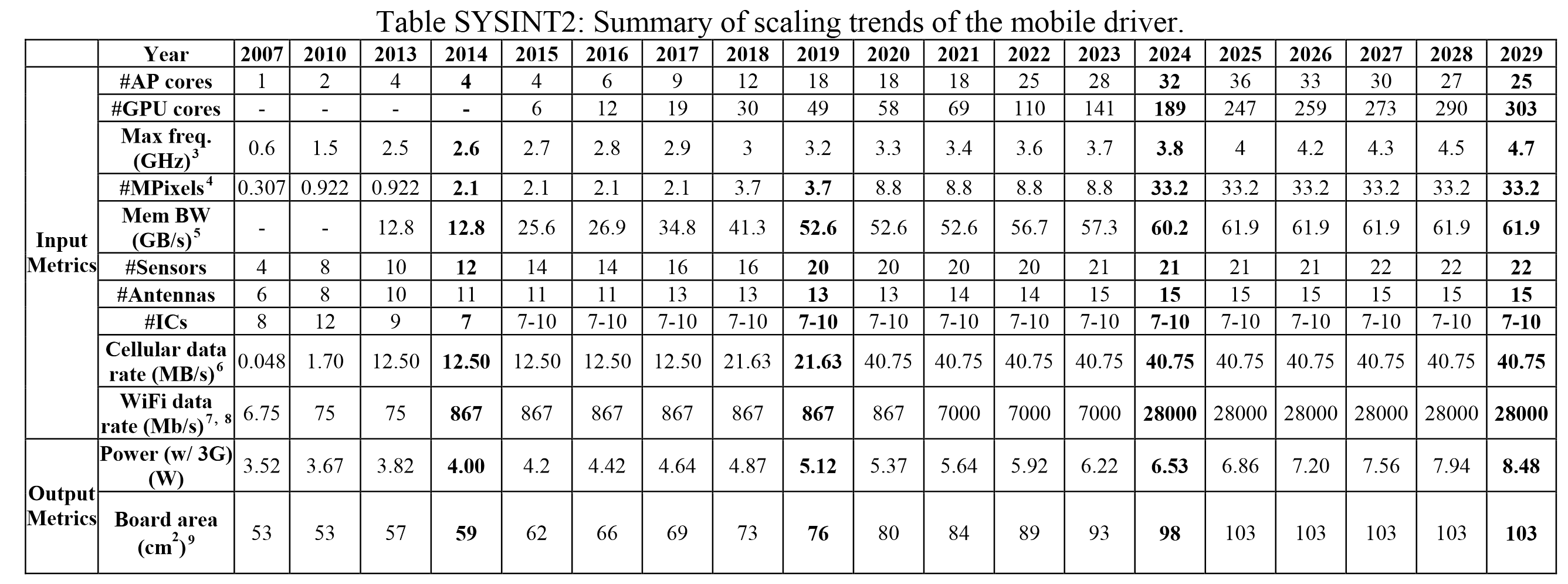Ten Year Anniversary of Core 2 Duo and Conroe: Moore’s Law is Dead, Long Live Moore’s Law
by Ian Cutress on July 27, 2016 10:30 AM EST- Posted in
- CPUs
- Intel
- Core 2 Duo
- Conroe
- ITRS
- Nostalgia
- Time To Upgrade
Looking To The Future: Mobile, 32-cores and 8K Displays
The volume of the mobile industry today is certainly a hot topic, especially with Intel scrapping their mobile platform as recently as April 2016. This primarily leaves ARM (who was recently acquired by Softbank) in the driving seat for providing the next decade of mobile processor designs. Because ARM sells licences, both processor licences and architecture licences, a number of ARM’s partners have taken the base instructions and decided to forgo ARM’s core designs for their own. This is why we currently see Samsung with their M1 core, Qualcomm with their Kryo core, and Apple with their Twister cores as well, while Huawei, Mediatek and others are combining parts of ARM’s core designs with various GPU designs either from ARM or Imagination. Getting the right combination of parts, as well as the industrial design, are key elements to the user experience as well as the mobile industry as a whole.
Then of course, Mediatek announced the Helio X20 last year, which is finally now in devices. This is a 10-core part, using a paradigm such that the most relevant cores needed for performance and power consumption are in play at the right time. The creation of a 10-core part made a number of industry analysts wonder which direction this market was going in, as on the one end we have the Helio X20, while Apple’s latest iPhone family were using dual-core designs of Apple’s custom implementation. So if 10-cores are too much, this roadmap might come a little surprising.
As we stand in 2016, this roadmap states we are currently in a 6-core mobile CPU arrangement with 12 GPU cores, with the CPU running at 2.8 GHz. Displays are around the Full-HD mark, with overall board power at 4.42W. Well we certainly have hex-core parts today (2xA57 + 4xA53), 12-core GPUs also exist in Apple’s products, and Samsung’s M1 core is rated at 2.8 GHz. Some phones, such as Sony’s Xperia Z5 Premium, already have 4K screens (8.3MP), which is more geared towards 2020 in this roadmap.
Cycle now from 2016 to 2025, almost 10 years in the future. ITRS’ roadmap states the following:
- 36-cores
- 247 GPU cores
- 4.0 GHz
- 8K Screens (33.2 MP)
- 61.9 GB/s memory bandwidth
- 28 Gbit/s WiFi
- 6.86W Board Power
- 103 cm2 board area
Now clearly, for this piece I conferred with our mobile team and I got a lot of confused faces. Even scaling down from 16nm in 2016 to 4nm in 2025, they felt that so many all-purpose cores in a chip (as well as all the GPU cores) was probably excessive, not only in terms of utility but also for 2D floor plan. In order to implement this, more z-height would be needed as well as appropriate 3D technologies in place. Andrei felt the frequency targets were more respectable, and the memory bandwidth would depend on how the silicon designers decided to implement on-package DRAM vs multi-channel implementations. The board power seemed a little excessive, if only because the laws of physics can’t change that drastically, and an increase in +50% board area just means a bigger device.











158 Comments
View All Comments
Dobson123 - Wednesday, July 27, 2016 - link
I'm getting old.3ogdy - Wednesday, July 27, 2016 - link
That's what I thought about when I read "TEN year anniversary". It certainly doesn't feel like it was yesterday...but it certainly feels as old as "last month" is in my mind and that's mostly thanks to i7s, FXs, IPS, SSDs and some other things that proved to be more or less of a landmark in tech history.close - Thursday, July 28, 2016 - link
I just realized I have an old HP desktop with a C2D E6400 that will turn 10 in a few months and it's still humming along nicely every day. It ran XP until this May when I switched it to Win10 (and a brand new SSD). The kind of performance it offers in day to day work even to this day amazes me and sometimes it even makes me wonder why people with very basic workloads would buy more expensive stuff than this.junky77 - Thursday, July 28, 2016 - link
marketing, misinformation, lies and the need to feel secure and have something "better"Solandri - Friday, July 29, 2016 - link
How do you think those of us old enough to remember the 6800 and 8088 feel?JimmiG - Sunday, July 31, 2016 - link
Well my first computer had a 6510 running at 1 MHz.Funnily enough, I never owned a Core 2 CPU. I had an AM2+ motherboard and I went the route of the Athlon X2, Phenom and then Phenom II before finally switching to Intel with a Haswell i7.
Core 2 really changed the CPU landscape. For the first time in several years, Intel firmly beat AMD in efficiency and raw performance, something AMD has still not recovered from.
oynaz - Friday, August 19, 2016 - link
We miss or C64s and AmigasArtShapiro - Tuesday, August 23, 2016 - link
What about those of us who encountered vacuum tube computers?AndrewJacksonZA - Wednesday, July 27, 2016 - link
I'm still using my E6750... :-)just4U - Thursday, July 28, 2016 - link
I just retired my dads E6750. It was actually still trucking along in a Asus Nvidia board that I had figured would be dodgy because the huge aluminum heatsink on the chipset was just nasty.. Made the whole system a heatscore. Damned if that thing didn't last right into 2016. Surprised the hell out of me.